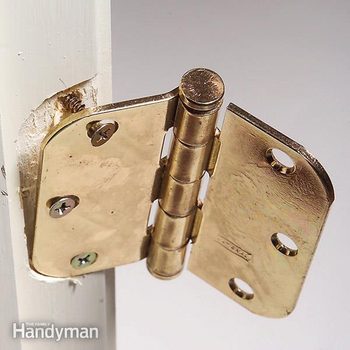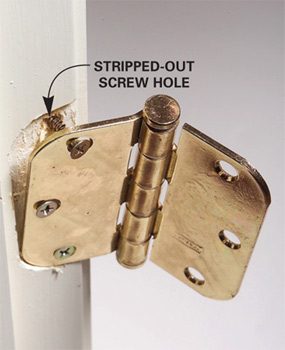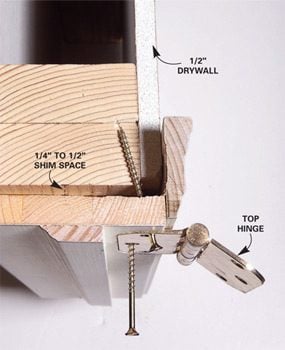How to Fix Hinge Screws
Updated: Jun. 30, 2017Get your door back into the swing of things.

Fix it forever
One day the door closes smoothly; the next day it's sticking. And the sticking grows worse as the weeks pass. It's a common old house problem, but it can happen anywhere kids hang from doorknobs.
The screws holding the top hinges carry most of the weight of the door and are almost always the first to pull out, especially after they've been repeatedly tightened over the years. The best way to beef them up is to replace the standard 3/4-in. hinge screws with at least two 3-in. screws that go through the jambs and solidly anchor into the framing. If the door has a large hinge with four screw holes, just drive 3-in. screws straight through the two holes toward the center of the door. However, if the hinge has only three holes, add a 3-in. screw through the middle hole and redrill the top screw hole at a slight angle so the screw hits solid wood.
Start the drill bit at a sharp angle so the bit doesn't follow the old screw hole. As soon as you feel a fresh hole starting, tip the drill bit back to an angle that will hit the stud—the angle shown here should work for most doors. If the bit or screw feels like it's sliding off to the side between the drywall and wood, redrill at a sharper angle.
Screw the hinge back in with yellow dichromate (zinc-plated) screws—the color and head size of these rust-resistant drywall screws are a good match for standard brass hinge screws. If the door doesn't shut properly after all the screws are driven in, they may have been driven in too far, pulling the door frame out of plumb. Just back the screws out a few turns.
Required Tools for this Project
Have the necessary tools for this DIY project lined up before you start—you’ll save time and frustration.
- Drill/driver - cordless
Required Materials for this Project
Avoid last-minute shopping trips by having all your materials ready ahead of time. Here’s a list.
- 3-in. yellow dichromate (zinc-plated) screws





